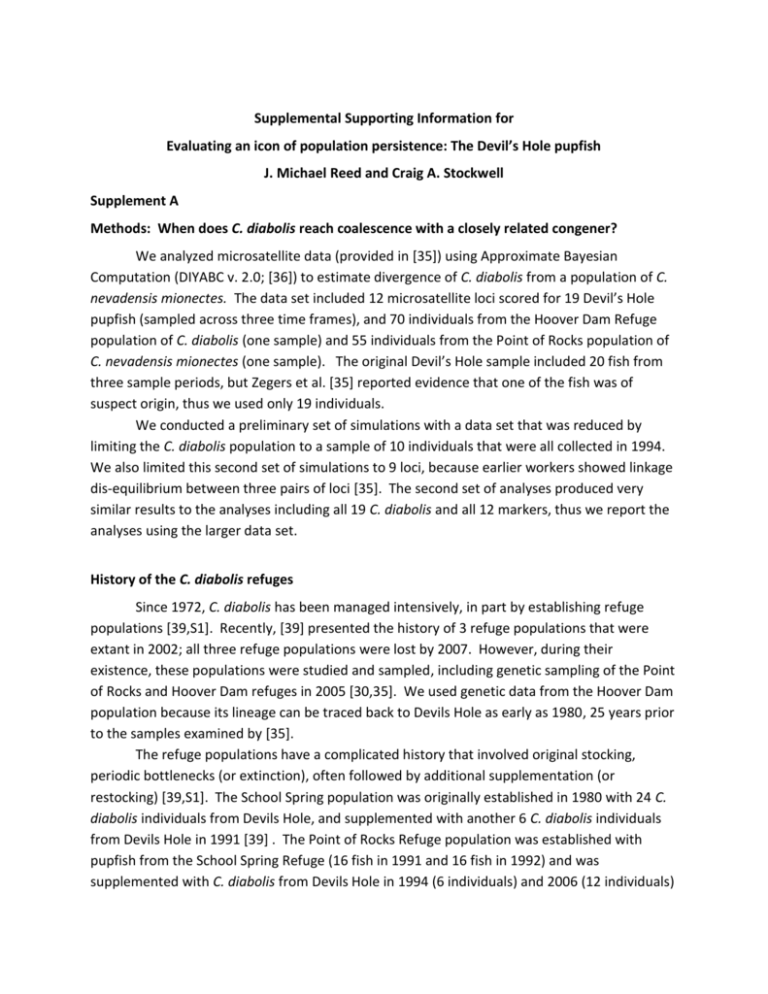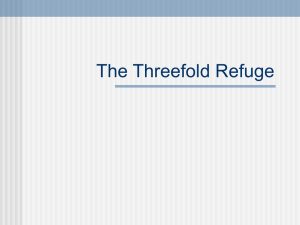A persistent, small, isolated population
advertisement

Supplemental Supporting Information for Evaluating an icon of population persistence: The Devil’s Hole pupfish J. Michael Reed and Craig A. Stockwell Supplement A Methods: When does C. diabolis reach coalescence with a closely related congener? We analyzed microsatellite data (provided in [35]) using Approximate Bayesian Computation (DIYABC v. 2.0; [36]) to estimate divergence of C. diabolis from a population of C. nevadensis mionectes. The data set included 12 microsatellite loci scored for 19 Devil’s Hole pupfish (sampled across three time frames), and 70 individuals from the Hoover Dam Refuge population of C. diabolis (one sample) and 55 individuals from the Point of Rocks population of C. nevadensis mionectes (one sample). The original Devil’s Hole sample included 20 fish from three sample periods, but Zegers et al. [35] reported evidence that one of the fish was of suspect origin, thus we used only 19 individuals. We conducted a preliminary set of simulations with a data set that was reduced by limiting the C. diabolis population to a sample of 10 individuals that were all collected in 1994. We also limited this second set of simulations to 9 loci, because earlier workers showed linkage dis-equilibrium between three pairs of loci [35]. The second set of analyses produced very similar results to the analyses including all 19 C. diabolis and all 12 markers, thus we report the analyses using the larger data set. History of the C. diabolis refuges Since 1972, C. diabolis has been managed intensively, in part by establishing refuge populations [39,S1]. Recently, [39] presented the history of 3 refuge populations that were extant in 2002; all three refuge populations were lost by 2007. However, during their existence, these populations were studied and sampled, including genetic sampling of the Point of Rocks and Hoover Dam refuges in 2005 [30,35]. We used genetic data from the Hoover Dam population because its lineage can be traced back to Devils Hole as early as 1980, 25 years prior to the samples examined by [35]. The refuge populations have a complicated history that involved original stocking, periodic bottlenecks (or extinction), often followed by additional supplementation (or restocking) [39,S1]. The School Spring population was originally established in 1980 with 24 C. diabolis individuals from Devils Hole, and supplemented with another 6 C. diabolis individuals from Devils Hole in 1991 [39] . The Point of Rocks Refuge population was established with pupfish from the School Spring Refuge (16 fish in 1991 and 16 fish in 1992) and was supplemented with C. diabolis from Devils Hole in 1994 (6 individuals) and 2006 (12 individuals) [39]. Finally, The Hoover Dam Refuge was established in 1998 with 10 C. diabolis individuals from the School Spring Refuge and 11 C. diabolis individuals Point of Rocks Refuge. This population was then supplemented with 20 C. diabolis in 2000 (10 individuals from each of the other two refuges). Although the Point of Rocks population was compromised by admixture with C .n. mionectes, the admixture was apparently restricted to this refuge population, as PCA showed that the Hoover population grouped with the native Devils Hole population, and both were distinct from the Point of Rocks Refuge population [30, 35]. Supplemental Reference S1. Baugh T, Deacon JE. 1988. Evaluation of the role of refugia in conservation efforts for the Devils Hole pupfish, Cyprinodon diabolis Wales. Zoo Biol. 7, 351-358. 2 Year 1972 1973 1974 1975 1976 1977 1978 1979 1980 1981 1982 1983 1984 1985 1986 1987 1988 1989 1990 1991 1992 1993 1994 1995 1996 1997 1998 1999 2000 2001 2002 2003 2004 2005 2006 2007 2008 2009 2010 2011 2012 2013 2014 Low Count 127 184 143 148 180 198 219 179 165 237 193 218 143 164 missing 180 236 223 226 215 238 226 310 217 252 164 227 197 181 159 161 124 123 84 38 38 45 70 121 104 63 35 92 Table S1. Survey results for Devil’s Hole pupfish. There are two surveys each year, with a systematic difference between the two because of the pattern of reproductive timing (i.e., higher counts come post reproduction). We used only the low-count data (before breeding) as they were not confounded by that year’s reproduction. Data depicted are those used in the demographic analyses, and they were provided by the U. S. Fish and Wildlife Service. 3 Table S2. Observed summary statistics compared to simulated summary statistics for the 5 DIY-ABC approximations. Allele Size Variance Approximation-1 Observed Summary Statistics+ One Population Summary Statistics C. n. C. diabolis C. diabolis C. n. C. diabolis C. diabolis mionectes Hole Refuge mionectes Hole Refuge 1.513 1.673 1.441 √ √ √ Approximation-2 C. n. C. diabolis mionectes Hole √ √ Two Population Summary Statistics Allele Size Variance C. n. mionectes C. diabolis - Hole C. diabolis - Refuge 2.251 2.510 FST C. n. mionectes C. diabolis - Hole C. diabolis - Refuge 1.597 √ √ 0.117 0.222 0.156 √* √* √ √* √* Goldstein’s δμ2 C. n. mionectes C. diabolis - Hole C. diabolis - Refuge 4.223 4.200 0.546 √ √ √* √ √ DAS1 C. n. mionectes C. diabolis - Hole C. diabolis - Refuge 0.038 0.026 0.156 √ √ √* + Observed Summary Statistics – to which simulations are compared *simulated significantly different from observed. 1 DAS – shared allele distance between populations i and j √ √ √ √ √ √* C. diabolis Refuge √ Table S2. Continued. Approximation-4 Approximation-3 One Population Summary Statistics C. n. C. diabolis C. diabolis C. n. C. diabolis C. diabolis mionectes Hole Refuge mionectes Hole Refuge Allele Size Variance √ √ √ √ √ √ Approximation-5 C. n. C. diabolis mionectes Hole √ √ √ √ √ √ √ √* C. diabolis Refuge √ Two Population Summary Statistics Allele Size Variance C. n. mionectes C. diabolis - Hole C. diabolis - Refuge √ √ FST C. n. mionectes C. diabolis - Hole C. diabolis - Refuge √* √* √ √ √ √ √ √* √* √ √ √ √* Goldstein’s δμ2 C. n. mionectes C. diabolis - Hole C. diabolis - Refuge DAS1 C. n. mionectes C. diabolis - Hole C. diabolis - Refuge √ √ √* *simulated significantly different from observed. 1 DAS – shared allele distance between populations i and j 5 COALESCENCE TIME Approximation 1 Approximation 2 Approximation 3 Approximation 4 Approximation 5 Years/Generations Ago Figure S1 DIYABC posterior probability distributions (green lines) and uniform priors (red lines) coalescence time between Cyprinodon diabolis and C. nevadensis mionectes for 5 approximations using different combinations of summary statistics; median in brackets (Table S1).






